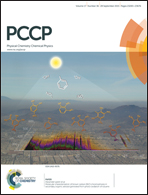Low temperature structural anomalies arising from competing exchange interactions in pyrochlore Nd2Ru2O7 probed by XRD and EXAFS†
Abstract
Quantitative structural parameters of pyrochlore Nd2Ru2O7, with temperature dependence, have been derived upon fitting XRD and EXAFS data. An anomalous expansion of the lattice parameter and the Ru–O bond length indicates a structural instability at low temperatures; in particular, an increase in the non-thermal term of the mean square fluctuation in the bond length is the evidence for a static disorder of Ru atoms. This static disorder is closely correlated with a decrease in the average Ru–O–Ru bond angle with decreasing temperature, favoring the short-range ferromagnetic coupling in the material. This ferromagnetic coupling formed thus triggered the spin frustration at low temperature when the contradictory constraints of antiferromagnetic interaction act upon the same Ru site in the corner-sharing tetrahedrons of pyrochlore Nd2Ru2O7. This study demonstrates that the spin frustration arising from the competition of ferromagnetic/antiferromagnetic interactions in pyrochlore Nd2Ru2O7 will cause structural instability especially on the atomic scale, which provides a new point of view to help understand its particular magnetic state.


 Please wait while we load your content...
Please wait while we load your content...